Paradox
Marine Bonsologist
I know what the Saratoga Nursery does and what they grow trees for.
JBP have not been planted on Long Island for about 34 years.
The Saratoga Tree Nursery stopped growing them around 34 years ago.
THE SARATOGA NURSERY DOES NOT GROW JBP ANY MORE.
They grow Scotch pines, Red Pines Pitch Pines and Eastern White Pines

My family member does erosion control plans for a living.
THEY DO NOT USE JBP FOR EROSION CONTROL ON LONG ISLAND, PEROID and havent for at least 30 years.
Again the fact sheet from 2018 AND the NYT article from 1988 YOU quoted both stated MOST OF THEM ON LONG ISLAND ARE DEAD
Lastly, I work for the goddammed agency you are quoting and deliberately leaving out details to try and prove your incorrect information.
AGAIN JAPANESE BLACK PINE ARE NOT USED FOR EROSION CONTROL ON LONG ISLAND AND THOSE THAT WERE PLANTED 35+ YEARS AGO ARE DEAD.
THERE ARE NO JBP STANDS ON LONG ISLAND
Last edited:

























